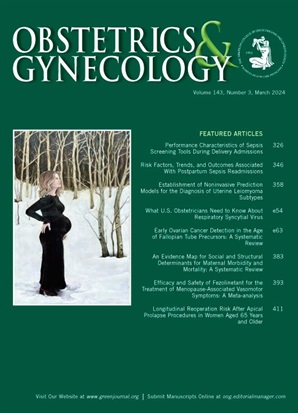Cost Effectiveness of Over-the-Counter Availability of Progestin-Only Contraceptive Pills in Abortion-Restrictive and Abortion-Protective Settings.
IF 4.7
2区 医学
Q1 OBSTETRICS & GYNECOLOGY
引用次数: 0
Abstract
OBJECTIVE To determine the cost effectiveness of a policy change making a progestin-only contraceptive pill available over-the-counter (OTC). METHODS We created a decision analytic model to determine the cost effectiveness of making an OTC progestin-only contraceptive pill available in the United States in two distinct policy environments: one in which abortion is legal and available and one in which abortion is restricted. Our theoretical population included 1,000,000 women at risk of unintended pregnancy over 1 year. We adopted the societal and payer perspective and obtained probabilities, utilities, and costs from the literature. We set the cost-effectiveness threshold at a standard $100,000 per quality-adjusted life-year (QALY). Our primary outcome was the incremental cost-effectiveness ratio. RESULTS In a theoretical cohort of 1,000,000 women at risk of unintended pregnancy, having an oral contraceptive pill available OTC was a dominant strategy in both settings; it reduced costs and improved QALYs. In settings in which abortion was available, having an OTC progestin-only contraceptive pill was associated with a $976-million reduction in costs and an increase of 14,153 QALYs. An OTC progestin-only contraceptive pill strategy would no longer be cost effective if more than 70% of OTC progestin-only contraceptive pill users discontinued usage; OTC progestin-only contraceptive pills would be cost effective for insurers to cover until the monthly cost exceeds $250 per pill pack in an abortion-protective setting. CONCLUSION The availability of an OTC progestin-only contraceptive pill is a cost-effective strategy in abortion-protective and abortion-restrictive settings.限制流产和保护流产的非处方黄体酮避孕药的成本效益。
目的确定政策变更使纯孕激素避孕药可在非处方(OTC)获得的成本效益。方法我们建立了一个决策分析模型,以确定在两种不同的政策环境下,在美国生产一种OTC纯孕激素避孕药的成本效益:一种是堕胎合法和可获得的,另一种是堕胎受到限制的。我们的理论人口包括1年内有意外怀孕风险的1,000,000名妇女。我们采用了社会和付款人的观点,并从文献中获得了概率、效用和成本。我们将成本效益阈值设定为每个质量调整生命年(QALY)的标准100,000美元。我们的主要结果是增量成本-效果比。结果在100万名有意外怀孕风险的女性的理论队列中,在这两种情况下,口服避孕药是主要的策略;它降低了成本,提高了质量周期。在可以堕胎的环境中,使用非处方纯孕激素避孕药可减少9.76亿美元的费用,并增加14,153个质量年。如果超过70%的非处方黄体酮避孕药使用者停止使用,那么非处方黄体酮避孕药策略将不再具有成本效益;在堕胎保护环境下,只有在每个月的费用超过250美元之前,保险公司才会承担非处方孕激素避孕药的成本效益。结论在人工流产保护和限制人工流产的情况下,使用非处方纯孕激素避孕药是一种经济有效的策略。
本文章由计算机程序翻译,如有差异,请以英文原文为准。
求助全文
约1分钟内获得全文
求助全文
来源期刊

Obstetrics and gynecology
医学-妇产科学
CiteScore
11.10
自引率
4.20%
发文量
867
审稿时长
1 months
期刊介绍:
"Obstetrics & Gynecology," affectionately known as "The Green Journal," is the official publication of the American College of Obstetricians and Gynecologists (ACOG). Since its inception in 1953, the journal has been dedicated to advancing the clinical practice of obstetrics and gynecology, as well as related fields. The journal's mission is to promote excellence in these areas by publishing a diverse range of articles that cover translational and clinical topics.
"Obstetrics & Gynecology" provides a platform for the dissemination of evidence-based research, clinical guidelines, and expert opinions that are essential for the continuous improvement of women's health care. The journal's content is designed to inform and educate obstetricians, gynecologists, and other healthcare professionals, ensuring that they stay abreast of the latest developments and best practices in their field.
 求助内容:
求助内容: 应助结果提醒方式:
应助结果提醒方式:


